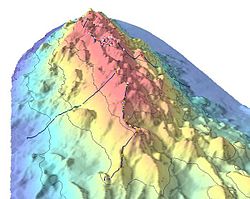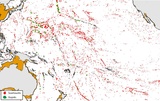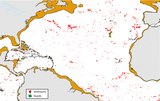Seamount


A seamount is a mountain rising from the ocean sea floor. It does not reach to the water's surface (sea level), and so is not an island. These are usually formed from submarine volcanoes. They are usually 1,000–4,000 metres (3,000–13,000 ft) in height from the sea floor.
The peaks are often found hundreds to thousands of metres below the surface, and so are in the deep sea.[1] There are an estimated 100,000 seamounts around the globe, but only a few have been studied. Seamounts come in all shapes and sizes, and follow a distinctive pattern of growth, activity, and death.[2] In recent years, several active seamounts have been observed, for example Loihi seamount in the Hawaiian–Emperor seamount chain.
Over time, the largest seamounts may reach the sea surface. There wave action erodes the summit to form a flat surface. After they have subsided and sunk below the sea surface such flat-top seamounts are called "guyots" or "tablemounts".
Seamounts are one of the most common oceanic ecosystems in the world. Interactions between seamounts and underwater currents attract plankton, corals, fish, and cetacea alike.[3] Their effect has been noted by the commercial fishing industry, and many seamounts support extensive fisheries. There are concerns about the effect of fishing on seamount ecosystems. There are well-documented cases of stock decline. 95% of ecological damage is done by bottom trawling, which literally scrapes whole ecosystems off seamounts.[4]
Most seamounts are not yet to be studied, or even mapped. Bathymetry and satellite altimetry are two technologies used to collect data. There have been instances where naval vessels have collided with uncharted seamounts. The Muirfield seamount is named after the ship that struck it in 1973. However, the greatest danger from seamounts are flank collapses. As they get older, water eats away at their sides. This causes landslides which, in turn, may cause massive tsunamis.
Seamount Media
Pillow lava, a type of basalt flow that originates from lava-water interactions during submarine eruptions
Grenadier fish (Coryphaenoides sp.) and bubblegum coral (Paragorgia arborea) on the crest of Davidson Seamount. These are two species attracted to the seamount; Paragorgia arborea in particular grows in the surrounding area as well, but nowhere near as profusely.
Because of overfishing at their seamount spawning grounds, stocks of orange roughy (Hoplostethus atlanticus) have plummeted; experts say that it could take decades for the species to restore itself to its former numbers.
Related pages
References
- ↑ Nybakken, James W. and Bertness, Mark D. 2008. Marine biology: an ecological approach. 6th ed, Benjamin Cummings, San Francisco.
- ↑ Shukman, David 2012. Rise and fall of underwater volcano revealed. BBC News Science & Environment [1]
- ↑ "Seamounts – hotspots of marine life". International Council for the Exploration of the Sea. Archived from the original on 13 April 2010. Retrieved 24 July 2010.
- ↑ Report of the Secretary-General, 2006. The Impacts of fishing on vulnerable marine ecosystems United Nations. 14 July 2006. Retrieved on 26 July 2010.
Other websites
- Earthref.org, Seamount Catalogue
- NOAA, Volcanic History of Seamounts in the Gulf of Alaska.
- USGS, Evolution of Hawaiian volcanoes Archived 2012-02-08 at the Wayback Machine







